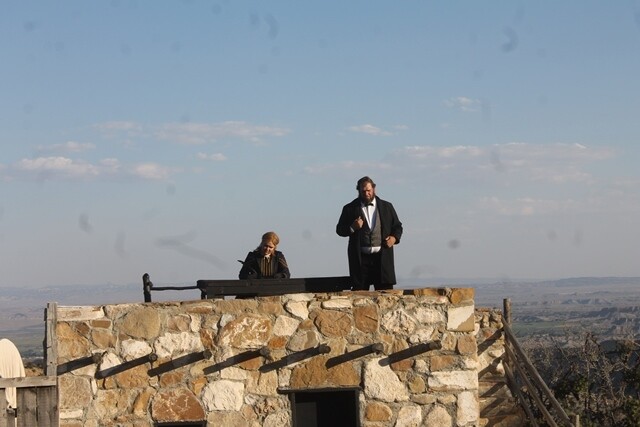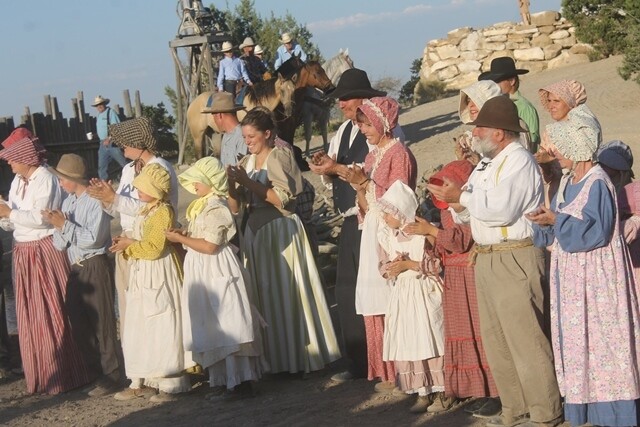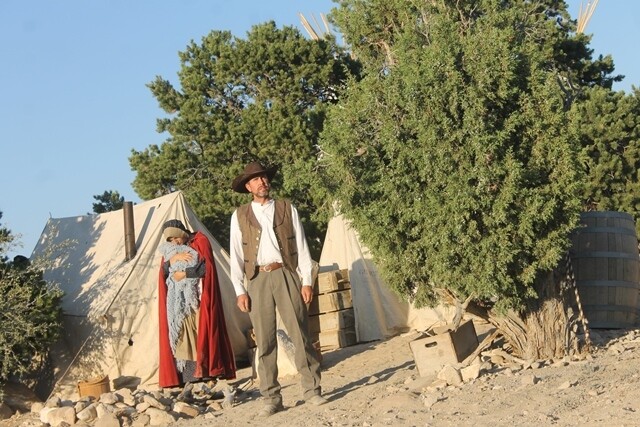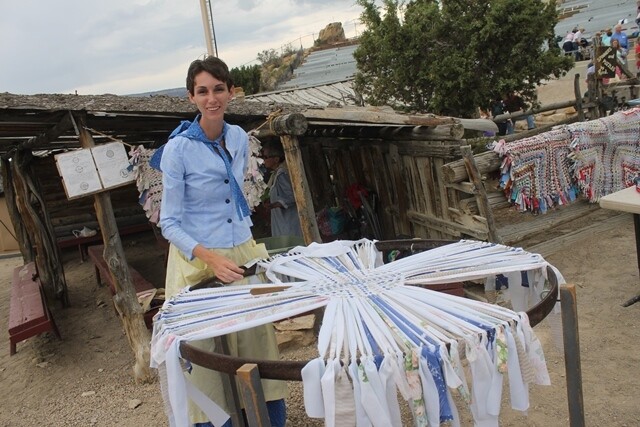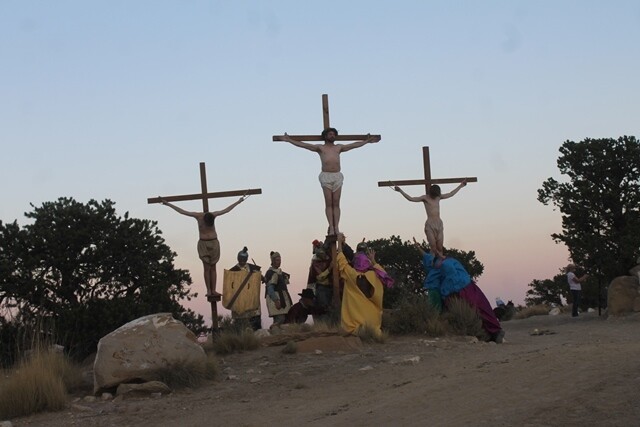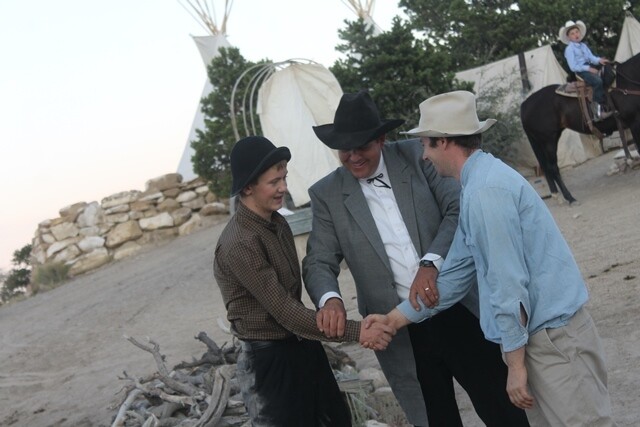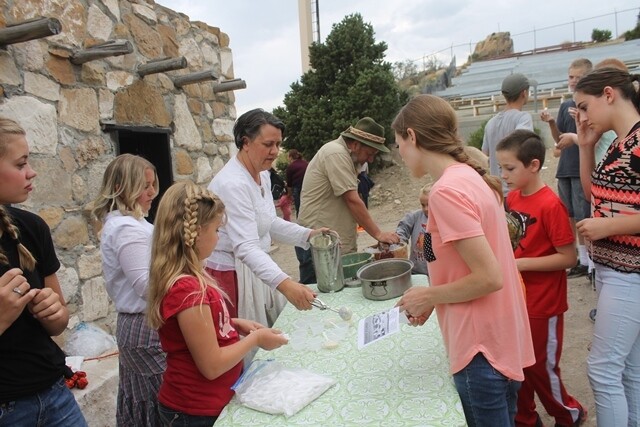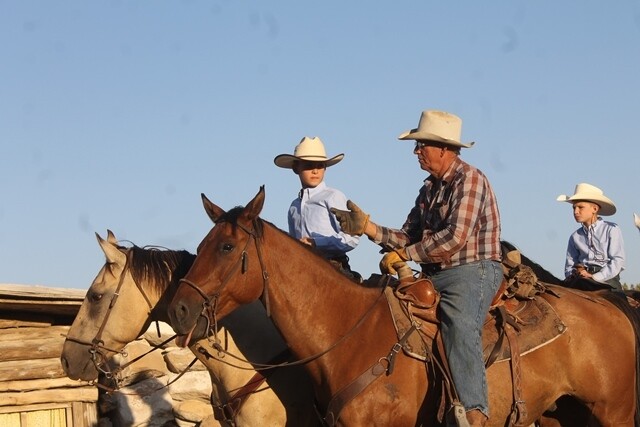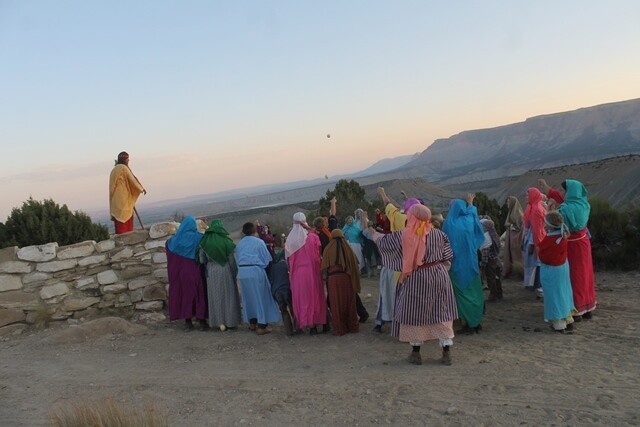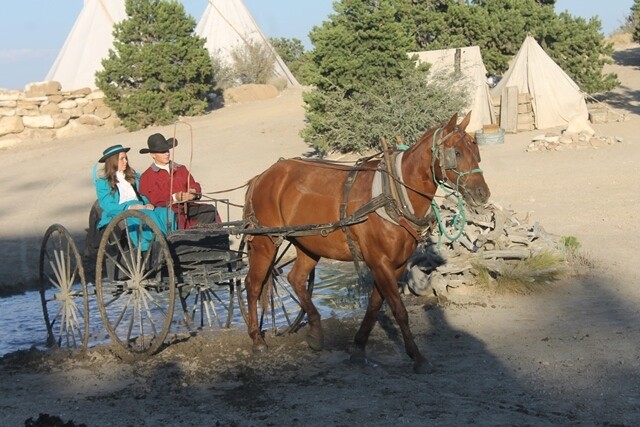Mud. Animals. Pioneers. Stories. Food. Flash floods. Everything you could possibly want to celebrate summer, the great outdoors, and pioneer history. And you can find it all at the Castle Valley Pageant in Castle Dale, Utah. One of a handful of pageants sponsored by the Church, the Castle Valley Pageant is based on true stories of pioneers who were called by Brigham Young to settle the Castle Valley area. And like its sister pageants, it inspires crowds of people every time it runs, just like it’s creator, Montell Seely, dreamed it would. Read on to learn about the miracles that accompanied the pageant’s beginning and what its cast and volunteer workers have to say about it.
*Note: This family adventure is only produced on even-numbered years and features a pioneer village before the pageant with crafts, activities, and costumes.
This year’s pageant will be held on August 2–4 and 7–11. No tickets or reservations are required. Click here for more information.
Pageant with a Purpose
As the last place Brigham Young ordered to be settled before he died, Castle Valley is a special area for many who live there or have ancestors who settled the valley. So it only makes sense that Brother Montell Seely wanted its history to be shared and commemorated.

“From a very early age, [Montell] had a deep devotion and reverence for the pioneers who sacrificed and gave their all to establish Zion in the tops of the mountains,” Montell’s daughter LeAnne shares. “He had seen a few pageants: one in North Carolina while serving his LDS mission; another, the outdoor production in Salt Lake City called 'Promised Valley'; and, of course, the Mormon Miracle Pageant in Manti. For years he had often thought, 'We need a pageant in Castle Valley. I wish someone would put together a pageant to pay honor to the stalwart pioneers who settled these western valleys.’ But he never thought of himself as the one who could or would be the driving force behind it!”
The pageant has been produced since 1978, and though many actors come and go, some local community members—Latter-day Saint or not—have been involved in the production for nearly 30 years. “The outdoor setting lends itself to making all feel comfortable,” LeAnne says. “The pageant is narrated by a father/son duo who seem to be out for a trail ride, and the stories are the result of questions from the son and stories from the father. Audience members don't just watch—they experience the pageant.”
Yet, this beautiful pioneer memorial had a long hard road before it became the beloved tradition that it is today.
The Show Must Go On
Montell had long dreamed of creating a pageant to share the story of the Castle Valley saints, but it wasn’t until 1977, when he was the bishopric member assigned to help the newly established ward activities committee, that he saw a possibility of bringing that vision to life. LeAnne Seely recalls, “Our Cultural Arts Specialist, Sister Driggs, asked him, ‘What should I be doing in my new calling?’ His response was, ‘What this area needs is a pageant that will tell the story of the colonization of Castle Valley.’” But though Sister Driggs was willing to attempt directing the pageant if someone else wrote it, finding a writer was more difficult. After searching and persuading, they could not find anyone willing to do it.
Montell, it seemed, was the only person who could carry out his vision.
LeAnne shares, “He did not consider himself a writer or even very much of a literary person. But he did already know the stories that should be portrayed. He had to teach himself to write dialogue and organize the scenes for the script.”
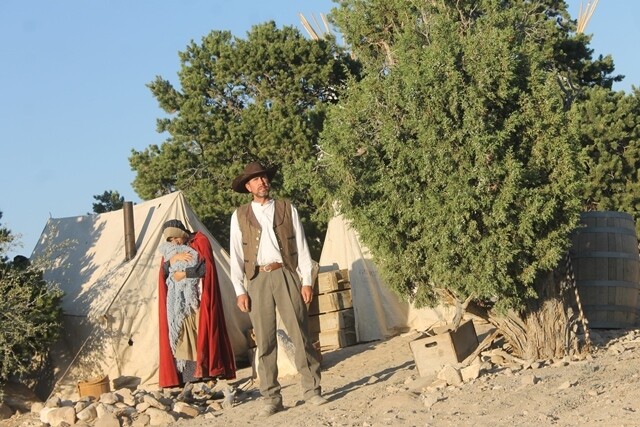
Though the task stretched Montell's talents and skills, he worked hard to develop realistic dialogue for the stories he knew he wanted to tell, and with some heavenly help, the script came together. As LeAnne describes it, “He didn't make a list of principles and lessons he wanted to portray, he just wrote the stories he knew that would appeal to people and touch their hearts. He said the script came to him from the Holy Ghost, not in a perfect form all at once, but little by little, with improvements over the years.”
The key was using real stories for the script, things that happened to the people along their way into the Castle Valley: a baby being born along the way, a baby dying along the way, and a reluctant wife, for example. These stories weren’t the only things being woven together during this process, however. Montell’s pageant was also bringing together his family and the community.
LeAnne remembers performing a scene from the pageant at a family reunion while her father was writing the first script. The family would also later work together to prepare the site for production. “When you sacrifice a lot for something, it tends to grow in importance,” she attests. The community has also come together to perform, set up, and manage the pageant. Perhaps one of the biggest sacrifices local neighbors have made is the raising and training of draft animals to use in the pageant. LeAnne confirms, “This shows a whole different level of devotion to the pageant! Any horses are expensive to buy, train, and feed, but draft horses are especially so. The success of the pageant is due in large part to the local people who maintain workhorses and who teach their children how to use them.”
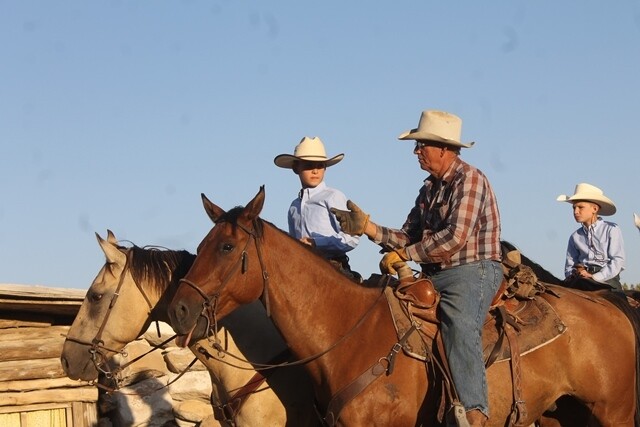
Soon after the script was written, preparations for a site to hold the pageant began. Montell found the perfect location, and it quickly came to life with the pouring of a concrete pad for the stage and benches for seating. A dugout was constructed in 1978 by Wayne and Elaine Wilberg, and a log cabin was donated that same year by Perry and Olive McArthur of Huntington in time for the first productions on August 11 and 12, 1978.
Reviving the Pioneer Spirit
Castle Valley Pageant president Brad Giles believes all those who watch this pageant can be uplifted and inspired by the history of the Mormon pioneers who were called by Brigham Young to settle the area. He shares, “It’s based on five different families, and three of those families are real families. The fourth is a composite of two separate families. And the fifth is not a direct history of the family, but it’s based again on something that happened. So they’re all based on truth and actual events and experiences.”
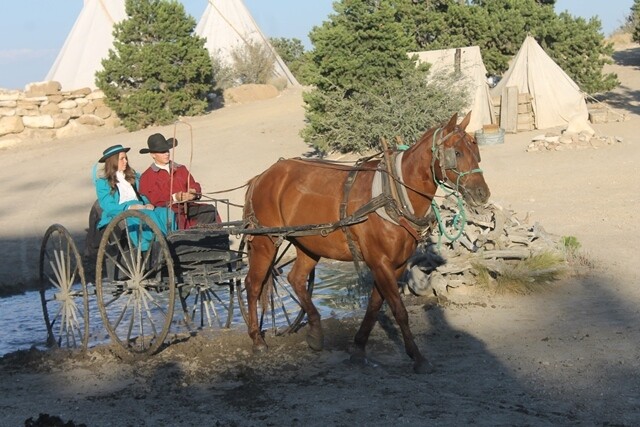
These experiences resonate with community members, bringing many of them back to participate year after year. “I went to it the first year, and then I knew some of the people in it and just asked how to get in it, and they told me to talk to Montell Seely,” says Bart Cox, who plays the harmonica in the pageant and has participated for nearly 40 years.
Pam Jeffs, whose husband, Lee, has been in charge of the horses and wagons almost since the pageant’s beginnings, explains that the family lives on the pageant hill for one month, doing chores and yard work in the daytime and preparing for the pageant in the evenings until Midnight. Sunday and Monday are days to rest. “The spirit is so strong, and it just pulls you to the hill,” she says.
Though the pageant as a whole draws its viewers in, those who have participated year after year have favorite scenes that they are drawn to in particular. For example, the mud scene depicting the settlers building irrigation ditches is a favorite among the children and is something they look forward to participating in when they are older. Loren Morse, who sees a more technical side of things through his job on the lighting, knows that without lights, there is no pageant. He describes one of his favorite scenes as the emotional depiction of the Crucifixion. “[The scene] is lit from, both sides from the front from probably 100-200 feet away. Then it’s backlit with some color—a little bit of light blue, which is kind of angelic looking—and then there’s some low light that comes in that’s kind of a turquoise color. The crosses are down and you can hear in the soundtrack a hammer pounding a stake. A railroad spike is what it sounds like. And then they raise up the two theives’ crosses, and then center cross with Christ on it rises up, and it just gets deathly quiet. The music plays and then thunder and lightning hit. It’s just a very, very emotional scene.”
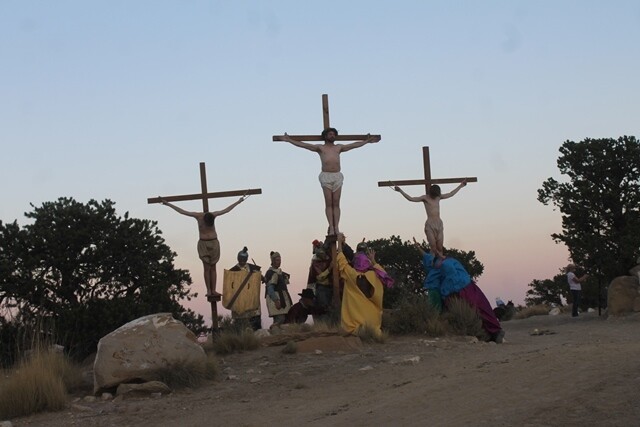
Pam’s favorite scene is connected with her grandson. “I love when the Savior appears to the Nephites. The scene is so real that [my 5-year-old grandson] reached out his hand for the Savior to touch him.”
Then and Now
Though the Castle Valley Pageant started as a one-ward production for two nights in August using borrowed spotlights and sound equipment, it quickly grew to be a stake production for three nights, a region-sponsored production for four nights, and eventually a Church-sponsored pageant held for eight nights every other year with its own sound and lighting crews.
“Over the years, the script has been revised, improved, and enhanced,” LeAnne shares. Her father, who was never afraid of critiques of the pageant, made many changes to the script and staging every year, trying to get things just right, including adding more parts for children and teenagers. Later on, when it was decided that the pageant could be a better missionary tool, they added flashback scenes that would teach about the Book of Mormon. By doing so, however, the production became too long, and they had to cut out a set of modern storylines that echoed the pioneer stories.

But the story isn’t the only thing that has evolved over the years. Morse, who spent most of his career running the lighting for events in the Tabernacle and Conference Center, including general conference and Music and the Spoken Word, had also helped wire many of the other Church pageants at Hill Cumorah, Mesa, and Nauvoo. He was eventually assigned to also help with the lighting at the Castle Valley Pageant. The first year of that assignment, he brought only a generator to the site and quickly realized that with all the rubber cords and poor equipment arrangements, they would have to spend the first year wiring the site the same as the other pageants. Morse recalls, “It was a generator I brought up there for probably 10 years, and then we finally got permanent power to the site, and that made it a lot better.”
Faith of Their Fathers
The pageant has undoubtedly grown since it was first created. And with it has grown a deeper appreciation for the sacrifices of the pioneers, the desire to connect with ancestors, and opportunities to build current family relationships.
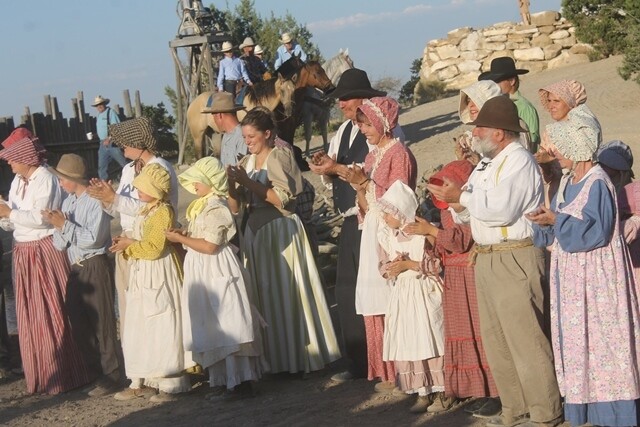
“When [Montell] asked me to be a part of the pageant, he didn’t know he was asking Pam and me to play the parts of my ancestors who settled Castle Valley,” Lee explains. “I think that was the real beginning of my wanting to get involved in my family history work. It has made me become more appreciative of my ancestors and what they did for me.”
Pam adds, “We have five children, and year after year they were involved with the pageant. It helped us grows closer as a family as we experienced different scenes throughout the pageant. My kids knew the entire script word for word. When the boys served missions, that was the time they got homesick—when they knew it was pageant time. All of our testimonies grew as we witnessed what our ancestors went through, watching as the Savior appears to the Nephites, and being taught the plan of salvation.”
LeAnne also has fond family memories associated with the pageant. “I remember many times when our family would drive to the pageant site (about 10 miles from our home) and spend several hours helping prepare the site for the production. We cleared rocks and boulders and helped build the set buildings. Some of my favorite memories are sitting around the kitchen table after performances and having milk and cookies while we talked about what went well with the show that night and what could be made better. We still do that whenever we can!”
Touching Hearts
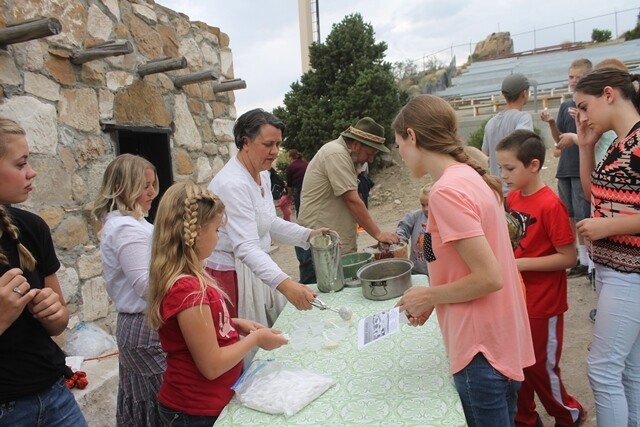
The feelings of love and connection and the Spirit that surround the pageant don't just affect the member families involved, however. Giles explains, “What we as a presidency tell everyone is that if you invite someone to come to the pageant with you or if you come to the pageant, you’ll be taught the gospel of Jesus Christ without really feeling like you’re being taught. Every scene except one depicts a principle of the gospel of Jesus Christ through this history telling. And we hope and we promise people that if they come that they will feel the Spirit. And their friends that they bring with them will feel something.”
And so they have. Pam knows of a neighbor who would never step inside a church building, but who would never miss the Castle Valley Pageant. She also shares that many inactive members are happy to help with the Pioneer Village that goes on before the pageant, providing horse rides and demonstrating rope making, quilting, and Dutch oven cooking.
“Every year we see people come to the pageant who are not members of the Church or who are inactive members,” Lee says. “I think they come to feel the Spirit as much as anything, whether they realize it or not. I’ve witnessed families come to see the pageant from out of state and decided to stay an extra night or two because they want to see it again and again.” There are dozens of these stories—of young men deciding to go on missions, of families having a renewed desire to get temple recommends or be sealed, of those who don’t know about the Church reaching out to the missionaries, and of tender mercies occurring.
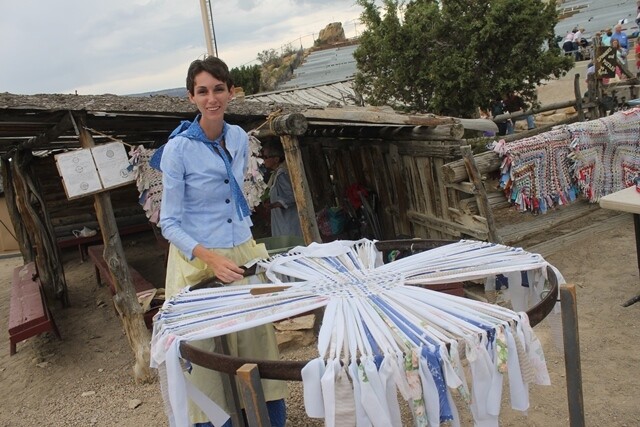
Morse recalls a tender mercy that happened one year when the automatic lighting console was not working, and he realized he would have to run in manually, which he hadn’t done for five or six years. He recalls, “It was time to start the show. I hadn’t even gotten a script down out of the trunk, I just plopped myself down at the console and just winged it. I just had this flood of emotion or the Spirit and . . . I nailed it. I was dead on. It was like no time had passed since I was there the last time.”
Those who love and have been involved in the pageant know that it has the potential to have a powerful effect on anyone who participates, whether as cast member or audience member. “The whole thing from start to finish, it fits, and it warms your heart. It will make you laugh, it will make you cry," Morse says. “As far as I’m concerned, from anybody’s perspective, it is a labor of love.” Pam hopes that those who take the time to watch will “realize the many sacrifices that their ancestors made in settling new areas. We need to be appreciative of those sacrifices. It was all in vain if we don’t follow in their footsteps and continue to build up the gospel.”
The Castle Valley Pageant is only produced on even-numbered years and features a Pioneer Village before the pageant with crafts and activities and costumes.
This year’s pageant will be held on August 2–4 and 7–11. No tickets or reservations are required. Click herefor more information.
All images courtesy of Patsy Stoddard
